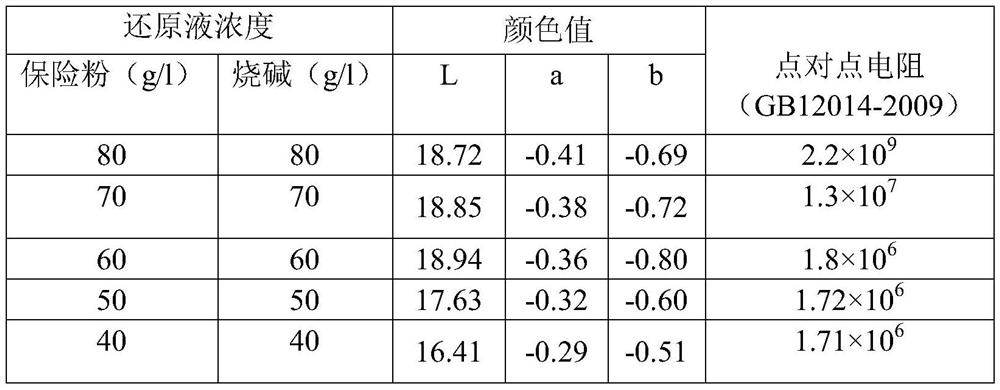Printing and dyeing process of antistatic fabric and antistatic fabric
An antistatic fabric, printing and dyeing process technology, applied in the direction of fabric elongation, fabric surface trimming, heating/cooling fabric, etc., can solve the problems of conductive fiber conductive layer damage, antistatic performance decline, etc., to meet the coloring requirements , Avoid damage to the conductive thread and preserve the electrostatic properties of the fabric
- Summary
- Abstract
- Description
- Claims
- Application Information
AI Technical Summary
Problems solved by technology
Method used
Image
Examples
Embodiment 1
[0052] A printing and dyeing process for antistatic fabrics, which comprises the following steps:
[0053] S1. Cooking and bleaching: new standard of antistatic fabric C20*16 / 128*60 carbon black grid 1*1 inlaid with static silk (the point-to-point resistance value of the gray cloth is 2.8*10 5 ), through seam turning and connection, in the bleaching liquid, through two dipping and two rolling treatments, the liquid rolling rate is 90%, and the vehicle speed is 80 m / min; 2 o 2 2.5g / l; caustic soda 10g / l; steam in a steam box at 70°C for 60 minutes, wash with hot water, rinse with seven grids of hot water, and dry after washing;
[0054] S2. Heat setting: The fabric after boiling and bleaching is set at high temperature, the setting temperature is 210°C, and the cloth is fed in reverse; the width of the heat setting fall cloth is 158cm, and the heat setting fabric is obtained after the treatment
[0055] S3. Singeing: remove the fuzz on the surface of the heat-setting fabric ...
Embodiment 2
[0059] A printing and dyeing process for antistatic fabrics, which comprises the following steps:
[0060] S1. Cooking and bleaching: the antistatic fabric cvc32*32 / 130*70*63 carbon black mesh 1.0 new standard inlaid with static silk (the point-to-point resistance value of the gray cloth is 4.1*10 5 ), connected through seam turning, through two dipping and two rolling treatments in the bleaching liquid, the liquid rolling rate is 80%, and the vehicle speed is 90 m / min; 2 o 2 2.5g / l; caustic soda 10g / l; steam in a steam box at 70°C for 60 minutes, wash with hot water, rinse with seven grids of hot water, and dry after washing;
[0061] S2. Heat setting: The fabric after boiling and bleaching is set at high temperature, the setting temperature is 210°C, and the cloth is fed in reverse; the width of the heat setting fall cloth is 158cm, and the heat setting fabric is obtained after the treatment
[0062] S3. Singeing: remove the fuzz on the surface of the heat-setting fabric ...
Embodiment 3
[0066] This embodiment is based on embodiment 1, and the difference with embodiment 1 is:
[0067] The flame length in the singeing step was 2.5 cm.
PUM
| Property | Measurement | Unit |
|---|---|---|
| length | aaaaa | aaaaa |
| length | aaaaa | aaaaa |
| length | aaaaa | aaaaa |
Abstract
Description
Claims
Application Information
 Login to View More
Login to View More - R&D
- Intellectual Property
- Life Sciences
- Materials
- Tech Scout
- Unparalleled Data Quality
- Higher Quality Content
- 60% Fewer Hallucinations
Browse by: Latest US Patents, China's latest patents, Technical Efficacy Thesaurus, Application Domain, Technology Topic, Popular Technical Reports.
© 2025 PatSnap. All rights reserved.Legal|Privacy policy|Modern Slavery Act Transparency Statement|Sitemap|About US| Contact US: help@patsnap.com



